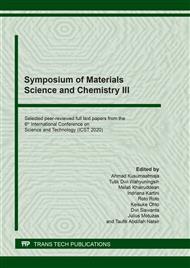[1]
SNI 8323:2016, Specification of Standard Sand (in Indonesian, Spesifikasi Pasir Standar, BSN 2016 (based on ASTM C778-13).
Google Scholar
[2]
B. Berhanu, Preparation of Ethiopian standard sand for the purpose of construction and testing, A Thesis submitted to the Graduate Study of Addis Ababa University, Ethiopia (2005).
Google Scholar
[3]
S.O. Ekolu, Potential South African standard sand for cement mortar testing and research, Proceeding of the First International Conference on Construction Materials and Structures, (2006), 253-260.
Google Scholar
[4]
A.F.M.S. Amin, M.M. Haque, M.Z.R. Siddiqi, M.A. Rahman, M.S. Islam, A.A. Rana, M.M. Karim, and M.K. Alam, Use of selected silica deposits of Bangladesh as standard sand in testing compressive strength of hydraulic cement mortars: A proposal for strength correlation, Journal of Civil Engineering, 40 (2), (2012) 181-202.
Google Scholar
[5]
O.O. Ojuri, and D.O. Fijabi, Standard sand for geotechnical engineering and geoenvironmental research in Nigeria: Igbokoda sand, Advances in Environmental Research, Vol. 1, No.4, (2012), 305-321.
DOI: 10.12989/aer.2012.1.4.305
Google Scholar
[6]
W. Pratiwi, G. A. Karim, and T. Rachmawati, Local silica sand as a substitute for standard ottawa sand in testing of cement mortar, Mater. Sci. Forum, vol. 1000 MSF, p.220–226, 2020. https://doi.org/10.4028/www.scientific.net/msf.1000.220.
DOI: 10.4028/www.scientific.net/msf.1000.220
Google Scholar
[7]
W. Pratiwi, G.A. Karim, and T. Rachmawati, The quality improvement of silica sand from Sidrap as standard sand in testing of cement quality, (in Indonesian), Jurnal Teknologi Bahan dan Barang Teknik, Vol. 8, No. 2, (2018), 63-70. http://dx.doi.org/10.37209/jtbbt.v8i2.120.
DOI: 10.37209/jtbbt.v8i2.120
Google Scholar
[8]
R. Polat, M.H. Yadollahi, A.E. Sagsoz, and S. Arasan, The correlation between aggregate shape and compressive strength of concrete: digital image processing approach, Int. J. of Structural and Civil Engineering Research, Vol. 2, No. 3, (2013), 62-80.
Google Scholar
[9]
S. Boggs, Jr., Principles of Sedimentology and Stratigraphy, 4th-edition, Pearson Prentice Hall, New Jersey, (2006).
Google Scholar
[10]
S. Ji and Z. Fang, Improving the roundness of foundry sands with artificial processing, International Journal of Cast Metals Research, 14:1, (2001) 37-42.
DOI: 10.1080/13640461.2001.11819423
Google Scholar
[11]
SNI 2149-2015, Semen Portland.
Google Scholar
[12]
W. Pratiwi, O. Sunara, G.A. Karim, E. Sofianti, D. Budiadi, and T. Rachmawati, Research on the substitution of Ottawa sand with local sand as a standard sand in controlling the national cement quality (in Indonesian), Internal Technical Report, Center for Material and Technical Product, Bandung, Indonesia, (2016).
DOI: 10.4028/www.scientific.net/msf.1000.220
Google Scholar


